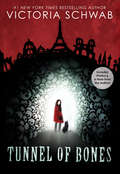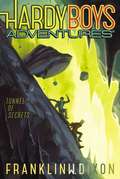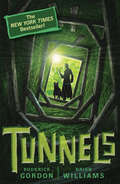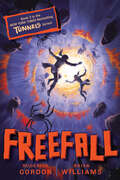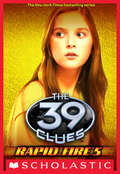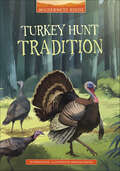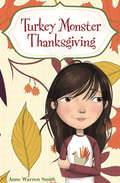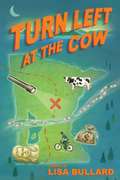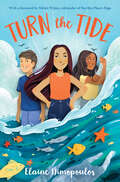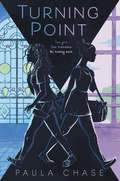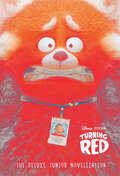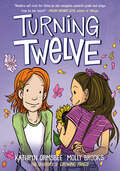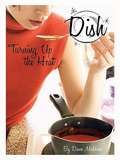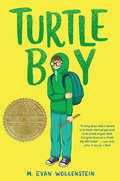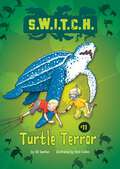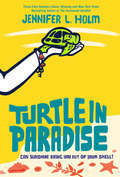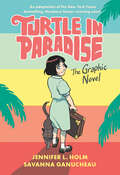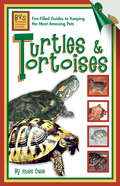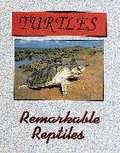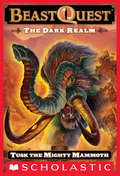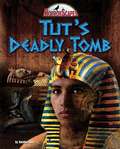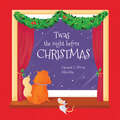- Table View
- List View
Tunnel of Bones (City of Ghosts #2)
by Victoria Schwab V. E. SchwabThe thrilling sequel to Victoria Schwab's New York Times bestselling City of Ghosts!Trouble is haunting Cassidy Blake . . . even more than usual.She (plus her ghost best friend, Jacob, of course) are in Paris, where Cass's parents are filming their TV show about the world's most haunted cities. Sure, it's fun eating croissants and seeing the Eiffel Tower, but there's true ghostly danger lurking beneath Paris, in the creepy underground Catacombs.When Cass accidentally awakens a frighteningly strong spirit, she must rely on her still-growing skills as a ghosthunter -- and turn to friends both old and new to help her unravel a mystery. But time is running out, and the spirit is only growing stronger.And if Cass fails, the force she's unleashed could haunt the city forever.#1 New York Times bestselling author Victoria Schwab returns to the spooky and heart-pounding world of City of Ghosts, delivering thrilling new adventures and an unforgettable spin on friendship. (Because sometimes, even psychic ghost best friends have secrets. . .)
Tunnel of Secrets
by Franklin W. DixonWhen Frank and Joe set out to explore caves and tunnels, they dig themselves into some dark and dangerous trouble in this Hardy Boys adventure.When a sinkhole opens up and swallows one of Bayport's historic statues, Frank and Joe suspect something--or someone--shady at play. They jump at the chance to investigate; Joe as a member of an urban exploration club, and Frank as photographer for the school paper. But in the thick of their search, the boys stumble upon an entire underground city that's been abandoned for years. Now the city is home to a cultish band of criminals who plan to take over Bayport. Frank and Joe are determined to shut down the crooks, but after being barreled down by a boulder and nearly squashed by a runaway train, they have to wonder: are they in over their heads?
Tunnels #1: Tunnels (Tunnels #1)
by Roderick Gordon Brian WilliamsThe New York Times Bestseller! The story of an outcast boy, his eccentric dad, and the scary underground world they discover through secret TUNNELS. 14-year-old Will Burrows has little in common with his strange, dysfunctional family. In fact, the only bond he shares with his eccentric father is a passion for archaeological excavation. So when Dad mysteriously vanishes, Will is compelled to dig up the truth behind his disappearance. He unearths the unbelievable: a secret subterranean society. "The Colony" has existed unchanged for a century, but it's no benign time capsule of a bygone era--because the Colony is ruled by a cultlike overclass, the Styx. Before long--before he can find his father--Will is their prisoner....
Tunnels #3: Freefall (Tunnels #3)
by Roderick Gordon Brian WilliamsTaking it down a whole 'nother level, Will and Chester journey to the deadly center of the earth in FREEFALL. By the authors of the NYT Bestseller TUNNELS--soon to be a major motion picture! DEEPER ended with Will and Chester head over heels in FREEFALL-- tumbling through the subterranean Pore with the evil Rebecca twins in hot pursuit, toting phials of the toxic Dominion virus. When, where, will they ever land? Just when the drop seems infinite, the boys hit bottom, and find themselves in a realm of near-zero gravity atop a giant spongy fungus stuffed with flesh-eating spiders. But the true threat lies closer; dangerously close to Will's heart. And above ground, black-clad Styx are sprouting like poison mushrooms, dead-set on spreading their plague!
Turbulence (The 39 Clues: Rapid Fire #5)
by Clifford RileyThe fifth of seven brand new 39 Clues stories, leading up to one explosive reveal. Amy Cahill knows her family needs to be prepared for the next Vesper attack, so she organizes a training weekend at the brand new Cahill command center. However, Dan and the others would rather goof off than hone their secret agent skills. Can Amy channel her inner leader and bring everyone in line? Or will a surprise appearance by a Vesper assassin prove that she's in over her head?
Turkey Hunt Tradition (Wilderness Ridge)
by Monica RoeTwelve-year-old April Clark is passionate about two things: woodworking and hunting, both skills learned from her beloved grandfather. But this year, GrandJack is recovering from a health problem and can’t join the trip to turkey camp. He tells her that a different sort of trip can still be great and gives her his prize box call to bring for luck. On the day of the hunt, April is determined to land the biggest, best tom she can. But her insistence on only getting the best turkey leads her to make a big mistake. Suddenly, the huge gobbler she’s bagged doesn’t seem quite so perfect. To make things right with GrandJack—and herself—April will have to figure out if different can still be good, and whether perfect really is best.
Turkey Monster Thanksgiving
by Anne Warren SmithBefore I knew it, Thanksgiving had turned into a monster . . .Thanksgiving was supposed to be easy for Dad and Tyler and me--spending the day in our pajamas and eating pizza--but I wondered what it would be like to try something else this year. Maybe I'd fix Thanksgiving--and my messy family, too. I couldn't help it. I started making lists . . .
Turn Down the Volume: Solving the Problem of Noise Pollution / The Dark Side of Light: Solving the Problem of Light Pollution (Fountas & Pinnell Classroom, Guided Reading Grade 5)
by Isaac BorromeoNIMAC-sourced textbook
Turn Left at the Cow
by Lisa BullardThirteen-year-old Trav has always wondered about his dead-before-he-was-born dad. But when he heads from California to his grandmother's house in rural Minnesota, hoping to learn about his past, he gets more than he bargained for. It turns out his dad was involved in a bank robbery right before he mysteriously disappeared, and the loot from the take is still missing. Along with Kenny and Iz, the kids next door, Trav embarks on a search for the cash. But the trio's adventure quickly turns dangerous when it becomes clear that someone else is looking for the money--someone who won't give up without a fight!
Turn the Tide
by Elaine DimopoulosTwelve-year-old Mimi Laskaris is inspired by the Wijsen sisters of Bali to turn her focus from classical piano to a new obsession: forming a grassroots, kid-led movement to ban plastic bags in her new island home in Florida. Written in accessible verse, this timely story of environmental activism has extensive back matter for aspiring activists. With a foreword by Melati Wijsen, cofounder of Bye, Bye Plastic Bags.Mimi has a plan for her seventh grade year: play piano in the Young Artists competition at Carnegie Hall with her best friend, Lee; enjoy a good old Massachusetts snow day or two; and work in her community garden plot with her dad. But all that changes when her family’s Greek restaurant falls on hard times.The Laskarises’ relocation to Wilford Island, Florida, is a big key change for Mimi. Where does she fit in in this shell-covered paradise without Lee? Mimi is taken by the beauty of the island and alarmed by the plastic pollution she sees on the beaches.Then her science teacher, Ms. Miller, shows her class a TED Talk by Melati and Isabel Wijsen. At ages twelve and ten, they lobbied to ban single-use plastic bags on their home island of Bali—and won. Their story strikes a chord for Mimi. She’s twelve.Could a kid like her make such a big change in a place that she’s not yet sure feels like home? Can she manage to keep up with piano, her schoolwork, and activism? And does confident and flawless Carmen Alvarez-Hill really want to help her with the movement?In this story of environmental activism, friendship, and self-discovery, Mimi figures out what’s truly important to her, and takes her place in the ranks of real-life youth activists like the Wijsen sisters, Greta Thunberg, and Isra Hirsi.
Turning Point
by Paula ChaseWhen being yourself isn't good enough, who should you be? Told in dual perspectives, this provocative and timely novel for middle-school readers by Paula Chase, the acclaimed author of So Done and Dough Boys, will resonate with fans of Jason Reynolds, Rebecca Stead, and Renée Watson. Best friends Rasheeda and Monique are both good girls. For Sheeda, that means keeping her friends close and following her deeply religious and strict aunt’s every rule. For Mo, that means not making waves in the prestigious and mostly White ballet intensive she’s been accepted to. But what happens when Sheeda catches the eye of Mo’s older brother, and the invisible racial barriers to Mo’s success as a ballerina turn out to be not so invisible? What happens when you discover that being yourself isn’t good enough? How do you fight back? Paula Chase explores the complex and emotional issues that affect many young teens in this novel set in the same neighborhood as her acclaimed So Done and Dough Boys. Friendship, family, finding yourself, and standing your ground are the themes of this universal story that is perfect for fans of Jason Reynolds, Rebecca Stead, and Renée Watson.
Turning Red
by DisneyRelive Disney and Pixar’s hit film Turning Red in this fun and hilarious junior novelization! Meilin Lee is a confident, dorky thirteen-year-old torn between staying her mother’s dutiful daughter and the chaos of adolescence. In addition to Mei’s changing interests, relationships, and body, she has started to “poof” into a giant red panda whenever she gets emotional . . . which is almost all the time! This junior novelization retells the full story and features eight pages of full-color images from the movie!
Turning Twelve: (A Graphic Novel) (From the Universe of Growing Pangs)
by Kathryn OrmsbeeTurning twelve means big changes--first bra, first time babysitting, and a first crush not everyone will approve of . . . a pitch-perfect coming-of-age graphic novel from the creators of Growing Pangs.A BOOKPAGE BEST BOOK OF THE YEAR&“Twelve cheers for Turning Twelve! Readers will root for Katie as she navigates seventh grade and stays true to her own heart.&” —Megan Wagner Lloyd, author of Allergic &“This book will appeal to fans of Raina Telgemeier, Kayla Miller, and Shannon Hale who are searching for their next favorite read.&” —Kirkus Reviews (starred review)What if a friend...is more than a friend?Katie can't wait to turn twelve--pool parties! babysitting! friends! But sometimes it feels like there's so much new stuff she can barely keep up. First Job? (Yes!) Unfair dress codes? (No way!) Make up (Okay?!) Shaving? (Uh…!)Maybe growing up isn't as much fun as she had expected. But one thing does seem right--her new friend, Grace. Could Katie have a crush on another girl? Katie knows not everyone around her will approve...which is kind of scary. She might not be ready to tell anyone yet, and that&’s fine...but can Katie stay true to herself and embrace the person she's growing up to be?
Turning Up the Heat (Dish #2)
by Diane MuldrowThe chef girls have decided to start a neighborhood cooking service. But they run into many obstacles, like their parents and money. Will they be able to come up with a recipe for success?
Turquoise Boy (Native American legends)
by Terri CohleneA retelling of a Navajo Indian legend in which Turquoise Boy searches for something that will make the Navajo people's lives easier. Includes a brief history of the Navajo people and their customs.
Turtle Boy
by M. Evan WolkensteinThis middle-grade debut, which will surely appeal to fans of Wonder, explores self-image, friendship, and grief, while highlighting the importance of taking chances. It will make you laugh and cry, and you will be eager to share it with someone you love.Seventh grade is not going well for Will Levine. Kids at school bully him because of his funny-looking chin. His science teacher finds out about the turtles he spent his summer collecting from the marsh behind school and orders him to release them back into the wild. And for his bar mitzvah community service project, he has to go to the hospital to visit RJ, an older boy struggling with an incurable disease. Unfortunately, Will hates hospitals.At first, the boys don't get along, but then RJ shares his bucket list with Will. Among the things he wants to do: ride a roller coaster, go to a concert and a school dance, and swim in the ocean. To Will, happiness is hanging out in his room, alone, preferably with his turtles. But as RJ's disease worsens, Will realizes he needs to tackle the bucket list on his new friend's behalf before it's too late. It seems like an impossible mission, way outside Will's comfort zone. But as he completes each task with RJ's guidance, Will learns that life is too short to live in a shell."A strong debut novel about grief, loss, and coming out of one's shell." --School Library Journal"Turtle Boy--both boy and book--is a winner." --Booklist, starred review"A beautiful debut that wears its heart on its sleeve" --TheNerdDaily"A masterful mingling of deeply resonant themes, including self-esteem, loneliness, loss, and the rewards of improbable friendships." --Publishers Weekly
Turtle Terror (S.W.I.T.C.H. #11)
by Ali SparkesWhen Petty Potts turns up on the beach, Josh and Danny decide to "borrow" her new S.W.I.T.C.H. spray—the formula that will turn them into turtles! A squirt and a spritz later, the boys cut loose completely, diving through the waves and slurping on jellyfish…until they swim into serious danger.
Turtle in Paradise (Turtle In Paradise Ser.)
by Jennifer L. HolmIn Jennifer L. Holm's New York Times bestselling, Newbery Honor winning middle grade historical fiction novel, life isn't like the movies. But then again, 11-year-old Turtle is no Shirley Temple<P><P> She's smart and tough and has seen enough of the world not to expect a Hollywood ending. After all, it's 1935 and jobs and money and sometimes even dreams are scarce. So when Turtle's mama gets a job housekeeping for a lady who doesn't like kids, Turtle says goodbye without a tear and heads off to Key West, Florida to live with relatives she's never met. <P>Florida's like nothing Turtle's ever seen before though. It's hot and strange, full of rag tag boy cousins, family secrets, scams, and even buried pirate treasure! <P>Before she knows what's happened, Turtle finds herself coming out of the shell she's spent her life building, and as she does, her world opens up in the most unexpected ways. <P> Filled with adventure, humor and heart, Turtle in Paradise is an instant classic both boys and girls with love.<P> Includes an Author's Note with photographs and further background on the Great Depression, as well as additional resources and websites.
Turtle in Paradise: The Graphic Novel
by Jennifer L. Holm Savanna GanucheauA graphic novel adaptation of the beloved, bestselling Newbery Honor-winning novel. Eleven-year-old Turtle is smart and tough and has seen enough of the world not to expect a Hollywood ending. After all, it's 1935 and money—and sometimes even dreams—is scarce. So when Turtle's mother gets a job housekeeping for a lady who doesn't like kids, Turtle heads off to Florida to live with relatives. Florida's like nothing Turtle's ever seen before, though. It's full of ragtag boy cousins, family secrets to unravel . . . and even a little bit of fun. Before she knows what's happened, Turtle finds herself coming out of her shell. And as she does, her world opens up in the most unexpected ways. Inspired by family stories, three-time Newbery Honor winner Jennifer L. Holm blends family lore with America's past in this charming gem of a novel, now adapted into graphic novel form by rising star Savanna Ganucheau.
Turtles & Tortoises
by Russ CaseIn Turtles & Tortoises beginning hobbyists of all ages will find amazing facts and useful information about turtles and tortoises from around the world. <P><P>Author Russ Case, a noted author and reptile and amphibian specialist, recommends the top twelve turtles and tortoises that are best for first-time keepers, not counting, of course, the familiar box turtle. From the smaller examples, like the mud turtle that grows only 5 inches, to the Galapagos giant tortoise, which can weigh over 700 pounds, Turtles & Tortoises opens up the whole captivating world of chelonians to the reader. This color guide covers the origins of these fascinating creatures as well as the health, feeding, housing, and care of these fascinating creatures.
Turtles and Tortoises
by James E. GerholdtSnakes, turtles, lizards, and alligators. Frogs, toads, and salamanders. This series examines two often misunderstood animal groups. Readers learn about characteristics, habitats, feeding, and reproduction of these fascinating creatures. -- Supports earth science curriculum-- Detailed text is an excellent resource for reports-- Colorful, close-up photographs of the animals capture and hold readers' attention while enhancing the text
Turtles of the Midnight Moon
by María José FitzgeraldWhen poachers threaten the island they love, two girls team up to save the turtles—and each other. An eco-mystery with an unforgettable friendship story at its heart from a fresh new voice in middle grade.Twelve-year-old Barana lives in a coastal village in Honduras, where she spends every spare minute visiting the sea turtles that nest on the beach.Abby is feeling adrift in sixth grade, trying to figure out who she is and where she belongs after her best friend moved away from New Jersey.When Abby&’s papi plans a work trip to Honduras, she is finally given the opportunity to see his homeland—with Barana as her tour guide. But Barana has other plans: someone has been poaching turtle eggs, and she&’s determined to catch them! Before long, Abby and Barana are both consumed by the mystery, chasing down suspects, gathering clues, and staking out the beach in the dead of night. . . . Will they find a way to stop the poachers before it&’s too late?A heart-pounding mystery with a hint of magic, María José Fitzgerald&’s debut novel explores the power of friendship, community, and compassion to unite all living creatures.
Tusk the Mighty Mammoth: Tusk the Mighty Mammoth (Beast Quest #17)
by Adam BladeStep into the Dark Realm--home to the most dangerous Beasts yet!Tusk the Mighty Mammoth rules the rotting forests of Gorgonia with razor sharp tusks. She terrorizes the rebels at war with the evil wizard Malvel and is holding Ferno the Fire Dragon captive. Can Tom and Elenna defeat Tusk before Malvel's guards track them down?
Tut's Deadly Tomb (HorrorScapes)
by Natalie LunisTUT'S DEADLY TOMB. The mummy of King Tutankhamun, the young Egyptian pharaoh, had not been disturbed for more than 3,000 years. In 1922, archaeologist Howard Carter and his team discovered the ancient tomb and examined the dazzling treasures within its chambers. Soon after the thrilling discovery, however, a member of Carter's team became ill and died. Stories of other deaths connected to the tomb followed. Had an ancient curse doomed those who had entered the pharaoh's tomb? Look inside to discover the truth behind these dark and spooky events.
Twas the Night Before Christmas: Edited By Santa Claus For The Benefit Of Children Of The 21st Century (Xist Children's Books)
by Clement C. Moore Sofia SitaThe creatures are stirring in this perennial holiday favorite as they wait for Santa Clause to arrive. An animal-centric take on the classic. Clement C. Moore&’s original poem, &“A Visit from St. Nicholas,&” has been brought to lovable life by the talented Sofia Sita. In this edition, the beloved poem is joined with delightful illustrations imagining the visit from the house&’s animals&’ perspectives. Children will be delighted to snuggle in for story time on Christmas Eve and wait for their own visit from Santa Claus after reading this book.
